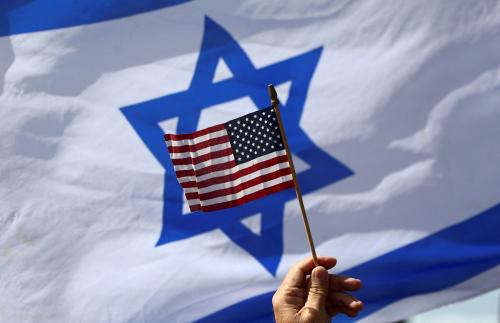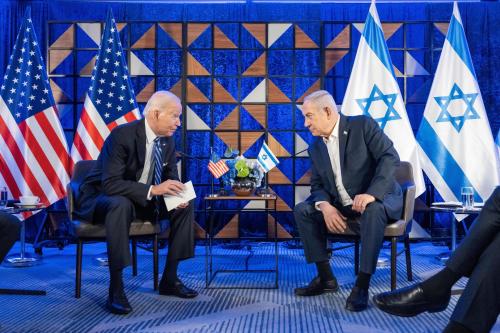During the past five decades, the Middle East has been shaped by several significant events and developments: the Iranian Revolution (1979), the fall of the Soviet Union (1991), the two Gulf wars (1991 and 2003), the Egyptian-Israeli peace treaty (1979), and the Oslo Process (1993-1995), to name a few. Among these events, the October War of 1973 (the “Yom Kippur War” as it is known in Israel, and the “October War” in Egypt and Syria) stands out as particularly influential.
A limited Egyptian-Syrian partnership
Egypt and Syria launched the October War on October 6, 1973. The Egyptian-Syrian partnership was limited. Syria’s President Hafez al-Assad did not fully share Egyptian President Anwar Sadat’s war aims. Sadat had in mind a limited war, a crossing of the Suez Canal, and the establishment of an Egyptian presence on the canal’s eastern bank in order to force Israel and the United States to enter into a diplomatic process designed to redress the consequences of the 1967 Six-Day War. The initial attack was unexpectedly successful. Sadat devised an effective strategy of using advanced Soviet surface-to-air missiles to neutralize Israel’s air force and armored units. He was also successful in surprising Israel and was unexpectedly aided by the mindset that affected the judgment of Israel’s intelligence community and political leadership.
That mindset meant that in the view of the leadership of Israel’s military intelligence, and part of the political leadership, capabilities were confused with intentions. In their view, Egypt would be unable to defeat Israel militarily and therefore was unlikely to start a war in which it was bound to suffer a defeat. It took Israel just over two weeks to recover and turn the tide of war. By the time a cease-fire was imposed by American and Soviet pressure, Israel had crossed the Suez Canal, threatened to decimate the Egyptian Third Army (a major part of the Egyptian military’s war contingency), and in the northern front reached the environs of Damascus. The war ended with a series of agreements culminating in the Egyptian-Israeli and Syrian-Israeli disengagement agreements of 1974.
Israel’s national trauma
The October War inflicted a national trauma on Israel. The intelligence failure, the surprise, the weak performance of the Israel Defense Forces during the war’s first few days, the large number of casualties, the dependence on resupply from the United States, and the huge economic cost mobilized the Israeli public against the Golda Meir government. There was a recognition that the massive victory of 1967 created in Israel a hubris that contributed to the setback of 1973. It also realized that the war could have been prevented had Israel accepted Sadat’s peace feelers between 1971 and 1973. Under public pressure, a commission of inquiry was established headed by Supreme Court Chief Justice Shimon Agranat. The commission decided to investigate just the military aspects of the war and did not deal with the responsibility of Prime Minister Golda Meir and Defense Minister Moshe Dayan.
Indeed, Meir and the Labor Party still won the first elections held after the war, but public protests forced the two of them to resign and a new government, headed by Yitzhak Rabin, was formed in 1974. As in other crises, the accounting happened later, when in 1977 the Israeli public voted the Labor Party out of office and elected Menachem Begin and his right-wing Likud Party. It was the first change of power in Israel after nearly 30 years of statehood, preceded by another three decades of Labor Party hegemony in the pre-state Zionist movement.
The beginning of an Arab-Israeli peace process
The post-October War diplomacy, led by the U.S. Secretary of State Henry Kissinger, also marked the beginning of an Arab-Israeli peace process. All previous efforts to settle the conflict, beginning in 1948, were short-lived and unsuccessful. But the mood created in both Egypt and Israel and Kissinger’s unusual skills shaped the transition from war to peacemaking. In Egypt and other parts of the Arab world, the feeling was that if Israel could not be defeated even after an initial setback, there was no prospect of an Arab military victory over Israel.
In Egypt though, the war was and is described as a victory, and the crossing of the Suez Canal is glorified as “The Crossing,” implying that a wide gap was victoriously crossed. This sense of achievement played an important role in enabling Sadat to carry his country into peacemaking with Israel. Sadat had wanted to disengage from the conflict with Israel since his assumption of power. His original concept of peace with Israel was more limited than the eventual outcome of the Camp David Accords, but he ended up signing a full-fledged peace agreement with Israel. The end of the Egyptian-Israeli military conflict was a huge asset in Israel’s national security equation.
In Israel, the course and cause of the war had a sobering effect on the public and the political system, thus enabling three prime ministers — Meir, Rabin, and later Begin — to make the concessions necessary for the interim agreements of 1974 and 1975, and eventually to the Camp David Accords of 1978. The war and its aftermath did not bring an end to the Arab-Israeli conflict, but it marked the beginning of a peace process that continued to unfold in the coming decades. It also marked the decision of several Arab states to distinguish — without necessarily admitting it — between their own state interests and their commitment to the Palestinian cause. In the short term, the October War contributed to the empowerment of the Palestinian Liberation Organization (PLO) and the Palestinian National Movement.
The war’s impact on the Middle East
In the regional politics of the Middle East, Sadat’s decision to move from a limited ending of the war into a peace process pitted Syria, his wartime partner, against Egypt. Under Assad’s leadership, a powerful and coherent Syrian state was built for the first time since independence. Assad sought hegemony in the Levant over Lebanon, Jordan, and the Palestinians, and cultivated an Arab coalition against Sadat and his policies. The new influence gained by Syria and the PLO contributed directly to the outbreak of the Lebanese civil war in 1975 and the collapse of the semi-democratic order that had been attained in independent Lebanon.
The October War and Washington’s support of Israel also led Saudi Arabia to deploy for the first time the “oil weapon” and announce an oil embargo on the United States, leading oil prices to quadruple. It was a turning point in the relationship between the oil-producing countries in the Middle East, the Western consumers, and the international oil companies, and it channeled huge revenues into the coffers of the Gulf countries. The full impact of these developments was not felt immediately, but in the coming decades, a series of developments, not all of them related directly to the October War, contributed to a shift of focus in the Arab world from Egypt and the Levant to the Gulf.
The war and postwar diplomacy contributed to the completion of Egypt’s move from the Soviet to the American orbit. Kissinger had argued in the Washington policy debate of the late 1960s that the United States should pressure Israel to give up on territories captured from Egypt and Syria only when these two countries had shifted from a pro-Russian to a pro-American orientation. He was unsuccessful with Syria, but fully successful with Egypt, thus completing one of the most dramatic diplomatic coups of the Cold War in the Middle East. The United States established itself as the only power, as distinct from the Soviet and European unions, capable of dealing with both Israel and its Arab adversaries and promoting the next phases of the Arab-Israeli peace process.
The impact and memory of the October War
In the immediate aftermath of the October War, its impact and memory dominated the public discourse in Israel. This discussion faded over the years as other developments came to overshadow it, including the signing of a peace treaty between Egypt and Israel six years after the war ended, which tended to soften the war’s impact on Israel. More recently, the October War’s memory is being evoked as its 50th anniversary is being marked, and even more so in the context of the current domestic crisis in Israel.
The protest movement that has been mobilized against the government’s efforts to overhaul the judicial system in Israel is comparing the severity of the current crisis to that of October 1973. Some of the more militant members of the protest movement are organized under the banner of “The Veterans of 1973,” and are inspired by the success of the protest movements of 1974 that forced Meir and Dayan’s resignations. Indeed, the memory of the war in Israel continues today as a symbol of leadership failure, the dangers of hubris, and the promise of overcoming near-defeat.







Commentary
Israel’s 1973 October War: A 50-year perspective
October 3, 2023